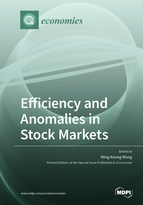Efficiency and Anomalies in Stock Markets
A special issue of Economies (ISSN 2227-7099).
Deadline for manuscript submissions: closed (31 May 2019) | Viewed by 101228
Special Issue Editor
2. Department of Medical Research, China Medical University Hospital, Taichung City 40447, Taiwan
3. Department of Economics and Finance, The Hang Seng University of Hong Kong, Hong Kong, China
Interests: behavioral models; mathematical modeling; econometrics; energy economics; equity analysis; investment theory; risk management; behavioral economics; operational research; decision theory; environmental economics; public health; time series analysis; forecasting
Special Issues, Collections and Topics in MDPI journals
Special Issue Information
Dear Colleagues,
The Efficient Market Hypothesis believes that it is impossible for an investor to outperform the market because all available information is already built into stock prices. However, some anomalies could persist in stock markets while some other anomalies could appear, disappear and re-appear again without any warning.
A Special Issue on "Efficiency and Anomalies in Stock Markets" will be devoted to advancements in the theoretical development of market efficiency and anomaly in the Stock Market, as well as applications in Stock Market efficiency and anomalies.
We invite investigators to contribute original research articles in theory, practice and applications of Efficiency and Anomalies in Stock Markets. All submissions must contain original unpublished work not being considered for publication elsewhere.
Prof. Dr. Wing-Keung Wong
Guest Editor
Manuscript Submission Information
Manuscripts should be submitted online at www.mdpi.com by registering and logging in to this website. Once you are registered, click here to go to the submission form. Manuscripts can be submitted until the deadline. All submissions that pass pre-check are peer-reviewed. Accepted papers will be published continuously in the journal (as soon as accepted) and will be listed together on the special issue website. Research articles, review articles as well as short communications are invited. For planned papers, a title and short abstract (about 100 words) can be sent to the Editorial Office for announcement on this website.
Submitted manuscripts should not have been published previously, nor be under consideration for publication elsewhere (except conference proceedings papers). All manuscripts are thoroughly refereed through a single-blind peer-review process. A guide for authors and other relevant information for submission of manuscripts is available on the Instructions for Authors page. Economies is an international peer-reviewed open access monthly journal published by MDPI.
Please visit the Instructions for Authors page before submitting a manuscript. Please refer to https://www.mdpi.com/journal/economies/apc for Article Processing Charge (APC). Submitted papers should be well formatted and use good English. Authors may use MDPI's English editing service prior to publication or during author revisions.






